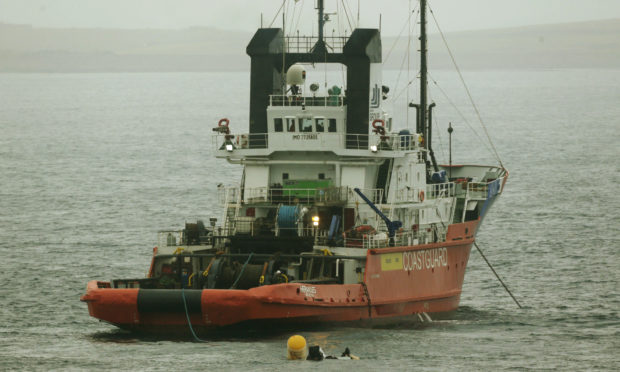Pilot error ultimately led to a horror helicopter crash off Shetland – killing four passengers on the tragic day – a fatal accident inquiry was told on its final day yesterday.
Four oil workers died when a Super Puma helicopter plunged into the sea while approaching to land at Sumburgh Airport on August 23, 2013. A survivor committed suicide four years later.
Crown Office advocate Martin Richardson, in giving his summing up evidence, agreed with a report by the Air Accidents’ Investigation Branch that flight instruments were “not monitored effectively” by the pilots in the moments leading up to the crash.
He said the lack of monitoring meant that a reduction in air speed from 80knots to 35knots was not noticed in time by the pilots to recover the helicopter from crashing into the sea two miles west of Sumburgh.
He said: “There was a failure to maintain target approach speed [of 80knots]. And that failure arose because the flight instruments were not effectively monitored by the flight crew.
“They failed to apply a stabilised approach. Each member of the flight crew had a freestanding duty to monitor [instruments]. The Crown’s position is the cause of that was pilot error.”
Highlands, Islands and Grampian Sheriff Principal Derek Pyle, who has been conducting the inquiry virtually because of Covid restrictions on courts, said he will considering the actions of the pilot, Captain Martin Miglans, and co-pilot Alan Bell in his findings, but added “both should be commended” for their actions following the crash, in particular Capt Bell who activated the flotation devices and liferaft.
He said he would also be “mentioning in some detail” the experience of the passengers following the accident “and what they went through when they were swimming around in the sea”.
Sheriff Pyle also stated he would be looking into “the time it has taken for this inquiry [to be held] and the obstacles the Crown had to surmount”.
Finally, the sheriff principal said: “I will certainly be asking the question, how safe are helicopters genuinely in the North Sea?”
Before closing the inquiry, he added: “This was a dreadful accident and it is obviously this has had a dreadful effect on the survivors and on the families and friends of the people who died.
“The importance of an inquiry like this is in order to find out what happened and to ensure that accidents of this type do not recur in the future.
“I extend my personal sympathy to all families involved and close the inquiry.”
He said a written determination would be issued within four weeks.
The passengers who died on the day were: Sarah Darnley, 45, of Elgin; Gary McCrossan, 59, of Inverness; Duncan Munro, 46, of Bishop Auckland; and 57-year-old George Allison, of Winchester.
A fifth victim, Samuel Bell, believed to be aged 28 and from the London area, committed suicide four years later.
The victims were among 16 offshore workers and two pilots travelling onboard a Eurocopter AS332 L2 Super Puma helicopter belonging to CHC Helicopters when it crashed.










